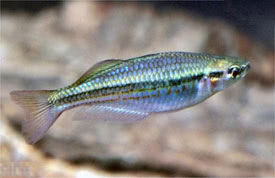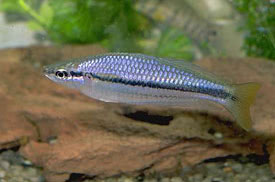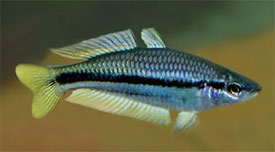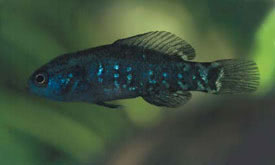
 Magyarul / Hungarian
Magyarul / Hungarian


- Scientific name: Melanotaenia nigrans
- Synonyms: Atherina nigrans, Atherinichthys nigrans, Nematocentris nigra, Rhombatractus archboldi, Zantecla pusilla
- Common name: Dark Australian Rainbowfish
- Group: Rainbowfish
- Habitat: Eastern Australia and coastal rivers of southwest Papua (New guinea).
- Size: 10-11 cm
- Biotope: The species lives in freshwater, but also enters brackish water
- Social behavior: Actively swimming, peaceful schooling fish.
- Diet: Live foods of all kinds, flake food is readily accepted.
- Breeding: Quite easy
- Tank: Minimum 100 litres
- Population: 4-5 fishes for 100 litres
- Decoration: Needs a fine substrate, moderate edge and background vegetation and a lot of free swimming space. The aquarium should receive some morning sun. The addition of sea salt is not absolutely necessary, but it can be added (1-2 teaspoons per 10 litres; 2,5 gallon of water)
- Temperature: 18-25°C
- pH: 6,7-7,8
- Hardness: 8-15NK°
- Lifespan: 3-5 years
Description: The males have brighter colors and larger dorsal and anal fins; both fins are edged in black. The back is yellow-gray and the belly is beige-white. The flanks are marked with a violet to green iridescence. A dark, black band runs from the snout through the eye and to the caudal fin. The females are plainly colored and have smaller dorsal and anal fins without the black outline. Melanotaenia nigrans is sensitive to sudden drops in temperature.
Breeding is totally nonproblematic. It is important that the animals are offered roomy breeding tank. Pairing is initiated by heavy chasing. During courtship, the males flare their fins and push the females into the plant thicket to spawn. The animals spawn daily over a period of 1 to 2 weeks. The eggs are attached to the plants by tiny threads. Their development takes 8-11 days. After a few additional days, the larvae are free-swimming. Feed them with micro food and crumbled flake food. If ripe females kept without males, they will expel mature eggs from time to time.
















